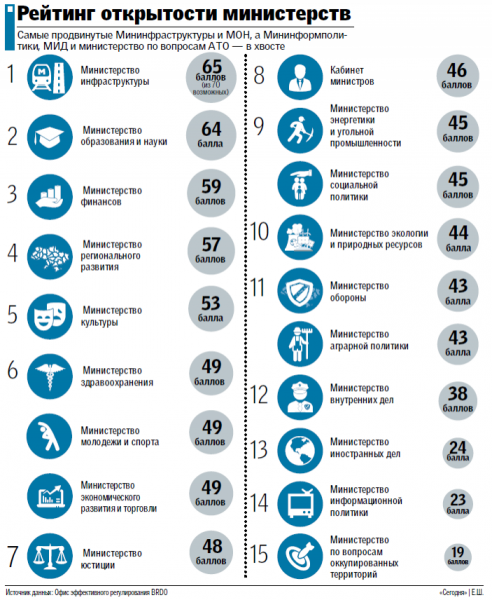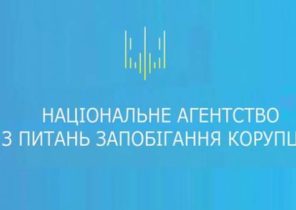
The Ministry of infrastructure of Ukraine recognized as the outdoor Ministry of the country — this according to the research Office effective regulation BRDO (created by the Ministry, the World Bank and the government of Canada). Behind him in the top 5 agencies also joined the MES, Ministry of Finance, Ministry of regional development and the Ministry of culture. But the structures with the most restricted access to public information became the newly created Ministry for the occupied territories, MIP and MIDA (see infographic).
VISION AND SEARCH. The authors of the study examined 18 websites of ministries and Cabinet on the subject of how much is available on them is public information for ordinary Ukrainians and observed whether the legislation in this area. Analysis conducted on seven items: transparency of information, the provision of open data, publicity plans, activities, publicity, reporting, work with citizens, interaction with the community councils and the fight against corruption.
Assessing information transparency, took into account the simplicity of the site structure, the presence of a version for the visually impaired, versions for different devices, and ease of finding. Here is the most recognized open mon, and most closed — the Ministry of the occupied territories. The same applies to publication of open datasets. “The websites do not show videos, presentations or infographics that would help to understand the site, its informative content and functionality — the authors of the study. For example, the Ministry or Mineralology have large amounts of necessary information, but find it extremely difficult. It is not structured”.
To evaluate the publicity plans for the future checked on the website of the Ministry schedule of work, description of long-term and short-term objectives, as well as the presence of a section with projects. According to this indicator, the leader of the MES and the worst indicators of the MIP.
Also an important point of evaluation is public accountability of government financial reports on the activities of the Department and information on public procurement. It turned out, the more likely other reports of the Ministry of Infrastructure and the indoor — mid. Among other things, looked at the work with applications of ordinary Ukrainians: is there on the website of the Ministry dedicated to this section and does electronic reception. Here is “another example” — the Ministry of Infrastructure. “The Ministry of Finance, the Ministry and the Ministry of Infrastructure has launched a fully electronic application and an online dialogue of citizens with representative offices in social networks,” — noted the authors of the study. And lagging behind was the Ministry of defense and Ministry of information policy.
The ANTICORRUPTION. In order to assess the level of interaction of the Ministry with the public Council, looked at the presence of a special section, how active it is updated and whether the work plan of the Council. Here, too, most of all succeeded mon, and the last place went to the Cabinet and the Ministry for the occupied territories.
The final criterion for the analysis of anti-corruption activities in the Executive branch, namely: does the site plan-schedule of actions for the fight against corruption whether there are separate phone and e-mail for messages of citizens about corruption, publication on the website of the annual income declarations of civil servants of corresponding level. The most active in this respect were as many as eight ministries (Ministry of Infrastructure, Ministry of justice, Ministry of sports, Ministry of defense, Ministry of coal industry, Ministry of education, Ministry of Finance), and the most passive — Cabinet of Ministers, the Ministry of social policy and the MIP.

Mobile app and search
According to researchers, ministries massively experienced problems with the ordering of the data: “the Ministry has not published data on the limit values of consumption of electric energy, and agricultural policy — information on forest fires, forest monitoring data. Particularly struck by the website of the Ministry of justice, where there is no search module. The potential of mobile applications is not used. Today, the proliferation of mobile gadgets allows you to develop mobile applications to work with actual databases, communication with ministries online, the latest news, discussion, projects. But, alas, none of the ministries have not yet started work in this direction.”







